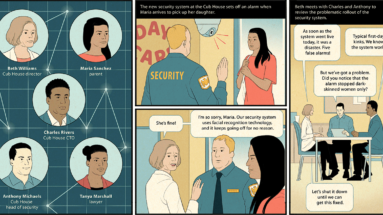November–December 2022
-

From the Sports Arena to the Business Realm
Teams Magazine ArticleHighlights from this issue
-

Revitalizing Culture in the World of Hybrid Work
Flex time Magazine ArticleThree strategies can help employees anywhere feel connected.
-

Negative Reviews Can Boost Sales Even More Than Positive Ones
Social marketing Magazine ArticleWhen people identify with a brand, they’ll defend it from attack.
-

The CEO of Hershey on Turning a Candy Company into a Snacks Empire
Corporate strategy Magazine ArticleHershey executed a bold new strategy by learning to be more entrepreneurial, adaptable, and agile.
-

What Does Your Company Really Stand For?
Personal purpose and values SpotlightAlign what matters to you as an organization with what matters to your employees.
-

Strategy in a Hyperpolitical World
Politics SpotlightHow to make smart choices when values clash
-

To See the Way Forward, Look Back
Business history SpotlightRevisiting your founding ideals can help sharpen your purpose and values.
-

The Ideas That Inspire Us
Business management Magazine ArticleTo celebrate HBR’s centennial, we asked eight current and former CEOs from some of the world’s top companies to describe the ideas that have propelled their own careers and organizations.
-

Number One in Formula One
Leadership Magazine ArticleLeadership lessons from Toto Wolff and Mercedes, the team behind one of the greatest winning streaks in all of sports
-

Your Company Needs a Space Strategy. Now.
Innovation Magazine ArticleRapidly falling launch costs and fleets of new satellites are opening up big opportunities for business.
-

The Five Stages of DEI Maturity
Diversity and inclusion Magazine ArticleHow to move from promises to results
-

From Prediction to Transformation
AI and machine learning Magazine ArticleTo realize their potential, AI technologies need new systems that leverage them.
-

How to Do Sponsorship Right
Mentoring Magazine ArticleMentorship isn’t enough. To develop productive career relationships, you’ve got to be authentic.
-

Can AI Really Help You Sell?
Sales Magazine ArticleIt can, depending on when and how you implement it.
-

Moving the Needle on Sustainability
Brand management Magazine ArticleYou can’t just get the product right—you may need to change consumer behavior too.
-

Make the Most of Your One-on-One Meetings
Managing yourself Magazine ArticleThey can be a highly effective leadership tool.
-

Case Study: Does Facial Recognition Tech Enhance Security?
Business and society Magazine ArticleThe new system in a day care center is producing biased results.
-

Our Social Media Addiction
Social media Magazine ArticleHow Facebook, Twitter, Instagram, YouTube, and TikTok took over our lives—and what to do about it
-

Life’s Work: An Interview with Jann Wenner
Entrepreneurship Magazine ArticleLessons from five decades of magazines and music
From the Editor
Idea Watch
Spotlight
Features
Experience
-
The CEO of Hershey on Turning a Candy Company into a Snacks Empire
Corporate strategy Magazine ArticleFor decades in the United States, the name Hershey has been synonymous with chocolate. From the iconic foil-wrapped Hershey’s Kiss to the chocolate syrup for milk or ice cream, the company’s offerings have been enjoyed by generations of consumers. Over its long history Hershey has found dozens of ways to keep innovating with chocolate and other sweet treats—different brands, flavors, sizes, packaging, and products—and taken them to other geographic regions.
In the past few years, however, the company has embarked on a more ambitious journey. First, it set a bold new strategy: to make Hershey a powerhouse in snacks as well as confections, by expanding into savory and better-for-you product categories. Then it streamlined global operations, bolstered its core businesses, developed a more courageous culture, and executed a series of diversifying acquisitions. In the process, Hershey became more entrepreneurial, adaptable, and resilient.
View Details 8.95BUY REPRINT -
What Does Your Company Really Stand For?
Personal purpose and values SpotlightThe authors conducted dozens of studies designed to determine how a clear view of one’s values can affect decision-making, motivation, relationships, well-being, leadership, and performance. They discovered that when a company’s official values match those of its employees—a situation they call values alignment—the benefits include higher job satisfaction, less turnover, better teamwork, more-effective communication, bigger contributions to the organization, and more-productive negotiations, not to mention more diversity, equity, and inclusion.
View Details 8.95BUY REPRINT -
Strategy in a Hyperpolitical World
Politics SpotlightThe assumption that business and politics can and even should be kept separate is no longer realistic, the authors write, and messaging from the corporate affairs department is insufficient to defuse political issues when they arise. Delta’s troubles in Georgia and Disney’s in Florida are among the examples they cite. To make and implement the best strategic choices in this environment, leaders will have to: (1) develop robust principles to guide strategic choices; (2) address ethical issues early; (3) consistently communicate and implement their choices; (4) engage with and beyond the industry to shape the context; and (5) learn from mistakes to make better choices in the future.
View Details 8.95BUY REPRINT -
To See the Way Forward, Look Back
Business history SpotlightMost business leaders focus on the future much more than on the past, believing that their job is to embrace disruption and innovation, transform their organizations, and explore new frontiers. But decades of research on companies worldwide shows that most successful ones are also guided by core values and a clear purpose. These can often be uncovered by conducting a thorough audit of a company’s history, original value statements, and purpose. Then leaders can decide what to preserve and what to let go—celebrating and collaborating around the good while acknowledging and moving on from the bad.
View Details 8.95BUY REPRINT -
The Ideas That Inspire Us
Business management Magazine ArticleHarvard Business Review published its first issue 100 years ago with a mission to help leaders put the best management thinking into practice. To mark our centennial, we asked eight current and former CEOs from some of the world’s top companies to describe the ideas that have propelled their own careers and organizations.
- Stéphane Bancel, the CEO of Moderna, on planning from the future back
- Anish Shah, CEO of Mahindra, on purpose-driven strategy
- Roz Brewer, CEO of Walgreens Boots Alliance, on listening as a leader
- Nicolas Hieronimus, CEO of L’Oréal, on global vision with local execution
- Joey Wat, CEO of Yum China, on continuous innovation
- Mo Ibrahim, former CEO of Celtel, on inclusive capitalism
- Ignacio Galán, CEO and chairman of Iberdrola, on transparent sustainability reporting
- Indra Nooyi, former CEO of PepsiCo, on performance with purpose
As we at HBR look to the future, we recommit to our mission of helping leaders build a better world for customers, employees, partners, and communities.
View Details 8.95BUY REPRINT -
Number One in Formula One
Leadership Magazine ArticleToto Wolff, the team principal for Mercedes-AMG Petronas—arguably the most impressive team in F1 racing history—has led his organization to unparalleled success. Mercedes earned the Constructors’ Championship (for best overall team performance) every year from 2014 through 2021, and over that time frame it won nearly 70% of the Grand Prix races it competed in.
To understand what made that possible, Harvard Business School’s Anita Elberse spent time with the team in 2021, conducting interviews and watching what went on behind the scenes before, during, and after races. She found that Wolff shapes the culture at Mercedes to a remarkable degree. Elberse’s takeaway? What you say and do as a leader has a surprisingly powerful effect on the organization you run.
In this article, drawing on her observations of Wolff’s management style and practices, Elberse presents six lessons that can help any leader cultivate a winning team: (1) Set the highest standards for everyone; (2) put people front and center; (3) analyze mistakes continually—even when winning; (4) foster an open, no-blame culture; (5) trust superstars but maintain authority; and (6) relentlessly battle complacency.
View Details 8.95BUY REPRINT -
Your Company Needs a Space Strategy. Now.
Innovation Magazine ArticleSpace is becoming a potential source of value for businesses across a range of sectors, including agriculture, pharmaceuticals, consumer goods, and tourism. To understand what the opportunities are for your company, the authors advise you to consider the four ways in which using space could create value: data, capabilities, resources, and markets.
For most companies thinking about their space strategy over the next five to 10 years, data will be the dominant focus. For instance, many companies are turning to remote-sensing satellites for data that will inform business decisions. Whether it’s tracking the number of cars parked in retail locations, detecting costly and environmentally damaging methane leaks from natural-gas wells, or assessing soil type and moisture content to maximize crop yields, creative uses for data gathered from space abound.
Companies looking further ahead will want to explore the value to be gained from conducting activities in space, utilizing space assets, and meeting demand from the new space age.
Businesses engaging with commercial space should be willing to experiment and should look for partners.
View Details 8.95BUY REPRINT -
The Five Stages of DEI Maturity
Diversity and inclusion Magazine ArticleMany organizations take big actions in the realm of DEI because of something they see another company do—such as publicly declaring themselves champions of people of color or setting an ambitious top-down DEI strategy across the firm. However, these grand stances usually fizzle out, leaving leaders frustrated and saying, “DEI work is too hard. It takes too long to see results.”
The fact is, DEI isn’t a short-term project, and a company making big moves before it has the right culture and structures in place is likely to fail, leaving marginalized employees and customers no better off and giving companies a reputation for hollow promises.
Academic research and the author’s experience working with firms on DEI strategy suggest that companies tend to follow predictable stages on their DEI journey. In this article, Georgetown professor and organizational psychologist Ella F. Washington describes the five stages: aware, compliant, tactical, integrated, and sustainable. She also includes questions for leadership teams to ask themselves. Understanding what stage your company is in can help you decide where to focus your energies most effectively and keep you from getting stuck.
View Details 8.95BUY REPRINT -
From Prediction to Transformation
AI and machine learning Magazine ArticleWhile the popular view is that insights are the key benefit of artificial intelligence, in truth AI creates value by improving the quality of decisions. The good news is, the opportunities for it to do that in business are countless. But because decisions in one area of an organization usually have an impact on decisions in other areas, introducing AI often entails redesigning whole systems. In that way, AI is similar to groundbreaking technologies of the past, like electricity, which initially was used only narrowly but ultimately transformed manufacturing.
Decisions involve a combination of prediction and judgment, and because AI makes highly accurate predictions, it will shift decision rights to where judgment is still needed, potentially changing who makes decisions and where, when, and how. More-accurate predictions in one part of a value chain will also have ripple effects on other parts. For instance, if a restaurant can reliably forecast the amount of ingredients it needs each week, its orders will fluctuate, making its suppliers’ sales more uncertain. Strong communication is needed to synchronize effort and resources in a system, and modularity will help prevent changes in one area from disrupting others.
View Details 8.95BUY REPRINT -
How to Do Sponsorship Right
Mentoring Magazine ArticleMentoring programs operate under the promise that matching seasoned executives with up-and-coming professionals will produce all sorts of benefits. Unfortunately, relationships often remain superficial and transactional. These problems have only gotten worse with remote and hybrid work, which makes meaningful personal interaction difficult.
To reap the full benefits of developmental relationships and create “authentic sponsorship,” companies must focus on two vital qualities: public advocacy and relational authenticity. Public advocacy is a one-way process by which “seniors” use their power to help “juniors” get career opportunities. It produces visible and measurable outcomes, such as promotions and stretch assignments. Relational authenticity is a two-way process in which both parties share their perspectives and make themselves open to hearing and learning from each other. Juniors get the support and validation they need to take on new challenges, and seniors understand where their juniors’ capabilities and talents lie and care enough about them to put their own reputations on the line.
This article lays out the various stages of the journey to authentic sponsorship: mentor, strategizer, connector, opportunity giver, and sponsor.
View Details 8.95BUY REPRINT -
Can AI Really Help You Sell?
Sales Magazine ArticleMany salespeople today are struggling; only 57% of them make their annual quotas, surveys show. One problem is that buying processes have evolved faster than selling processes, and buyers today can access a wide range of online resources that let them evaluate products before even meeting a salesperson. AI tools can help organizations close the gap, but most don’t know how to use them effectively. In this article the authors describe how sales AI has been a real game changer at a few companies. They also provide a self-assessment tool, the Sales Success Matrix, that will show sales leaders where to start or improve their AI journeys.
The matrix has two dimensions: relationship level (which runs from transactional vendor on the low end to trusted co-creator at the top) and process level (which runs from ad hoc to customized). At the lower levels of both relationships and processes, simple AI that decreases costs and improves efficiency works best. In the mid levels, advanced AI increases sales effectiveness by analyzing opportunities and customer needs. At the highest level, cutting-edge technologies help firms generate deep insights about customers.
No matter where a firm falls on the matrix, AI can help it boost sales. And the sooner and more broadly it applies AI tools, the better they work.
View Details 8.95BUY REPRINT -
Moving the Needle on Sustainability
Brand management Magazine ArticleMany sustainability initiatives focus on improving the sustainability of products and operations in legacy or adjacent markets or on achieving sustainability gains by exploring new markets with a more diverse set of products. This is a variation on the classic “where to play/how to win” strategy familiar to most executives. Fewer leaders, however, are exploring an important new frontier in sustainability, in which brands actively partner with customers to achieve ongoing impact.
This article describes a practical framework for creating sustainability strategies that take into account both dimensions—markets and customer engagement. The model lays out the four key ways that legacy companies can nurture growth in their sustainability efforts.
View Details 8.95BUY REPRINT -
Make the Most of Your One-on-One Meetings
Managing yourself Magazine ArticleFew organizations provide strong guidance or training for managers on meeting individually with their employees, but the author’s research shows that managers who don’t hold these meetings frequently enough or who manage them poorly risk leaving their team members disconnected, both functionally and emotionally. When the meetings are done well, they can make a team’s day-to-day activities more efficient and better, build trust and psychological safety, and improve employees’ experience, motivation, and engagement at work. The author has found that although there’s no one-size-fits-all approach to one-on-ones, they are most successful when the meeting is dominated by topics of importance to the direct report rather than issues that are top of mind for the manager. Managers should focus on making sure the meetings take place, creating space for genuine conversation, asking good questions, offering support, and helping team members get what they need to thrive in both their short-term performance and their long-term growth.
View Details 8.95BUY REPRINT -
Life’s Work: An Interview with Jann Wenner
Entrepreneurship Magazine ArticleLife’s Work: Jann Wenner
The cofounder of Rolling Stone discusses how a magazine launched on the fly revolutionized music journalism, changed the way politics and social issues were covered, and promoted great talent.View Details 8.95BUY REPRINT